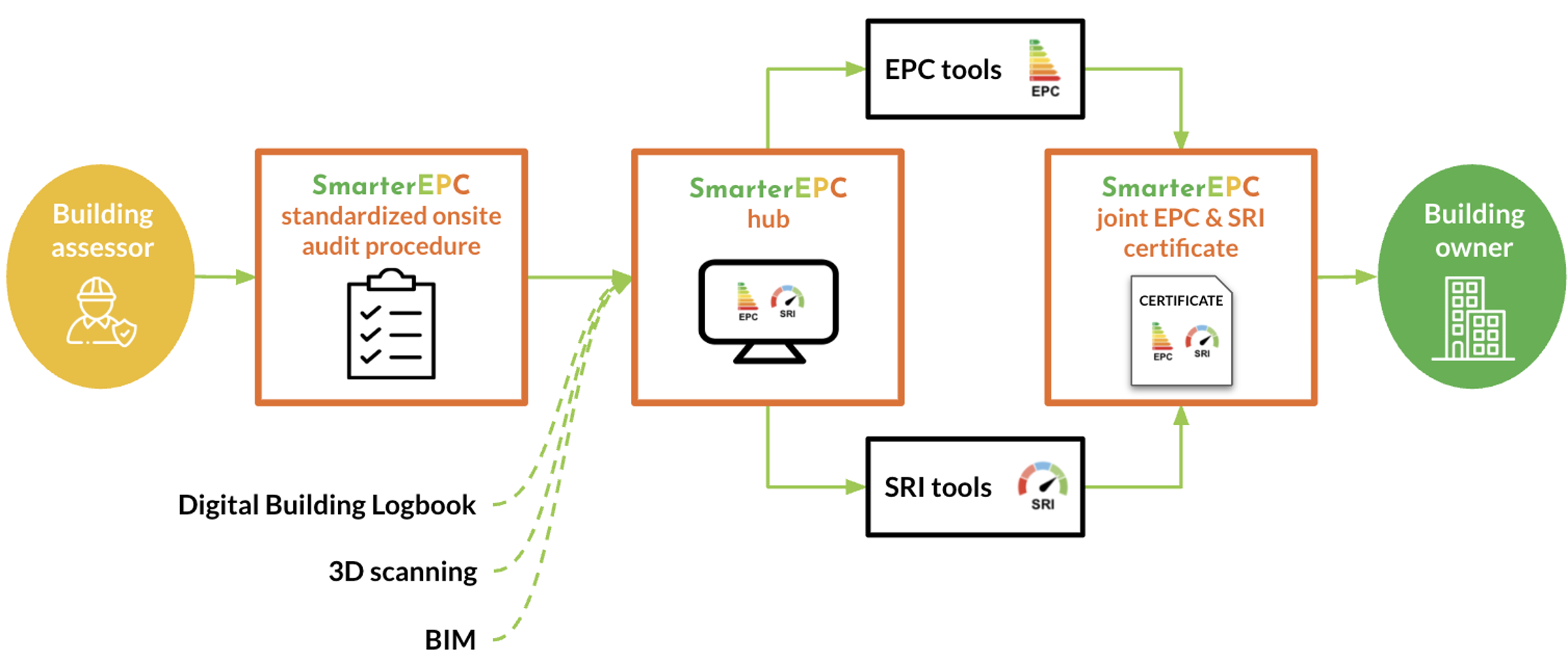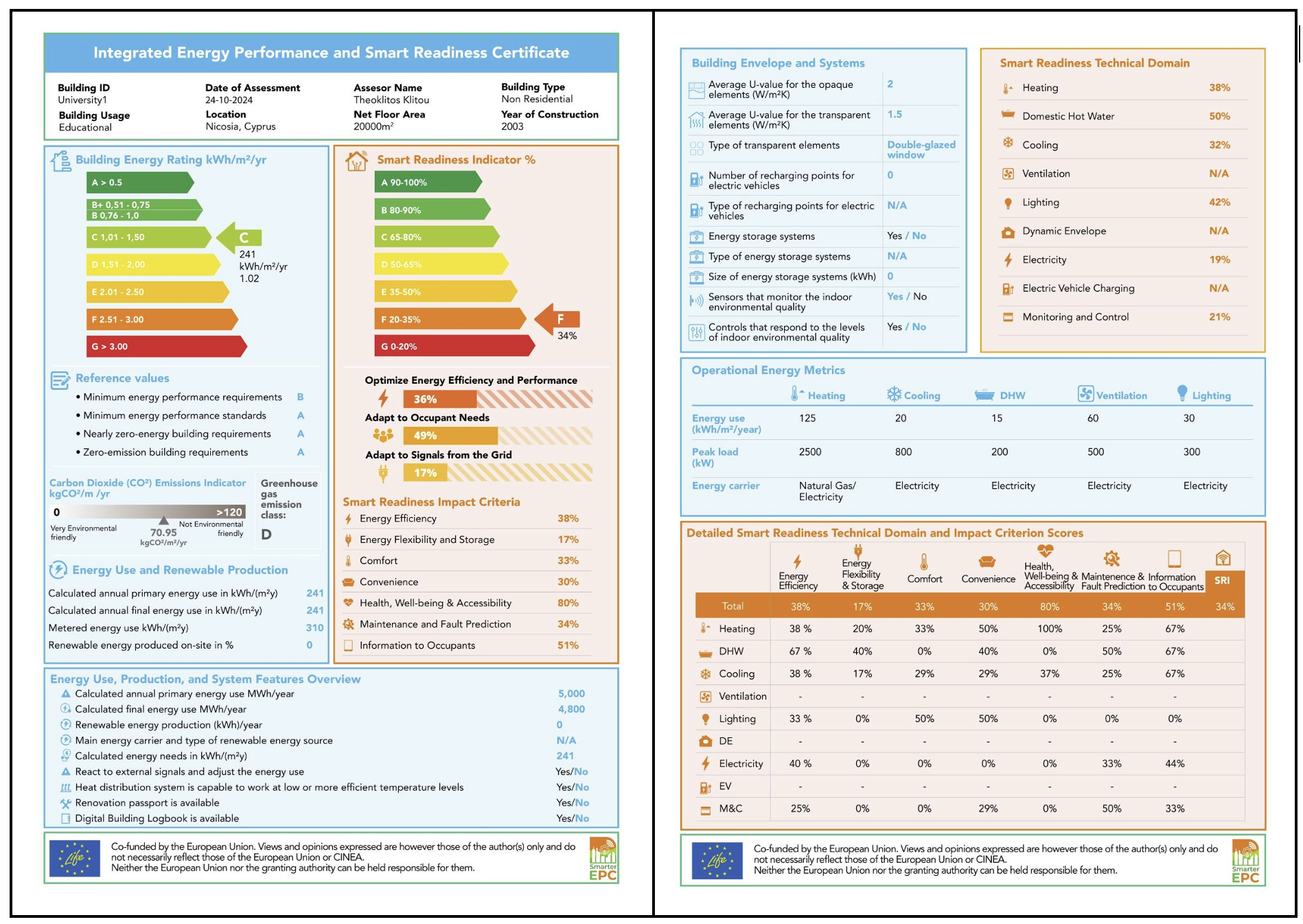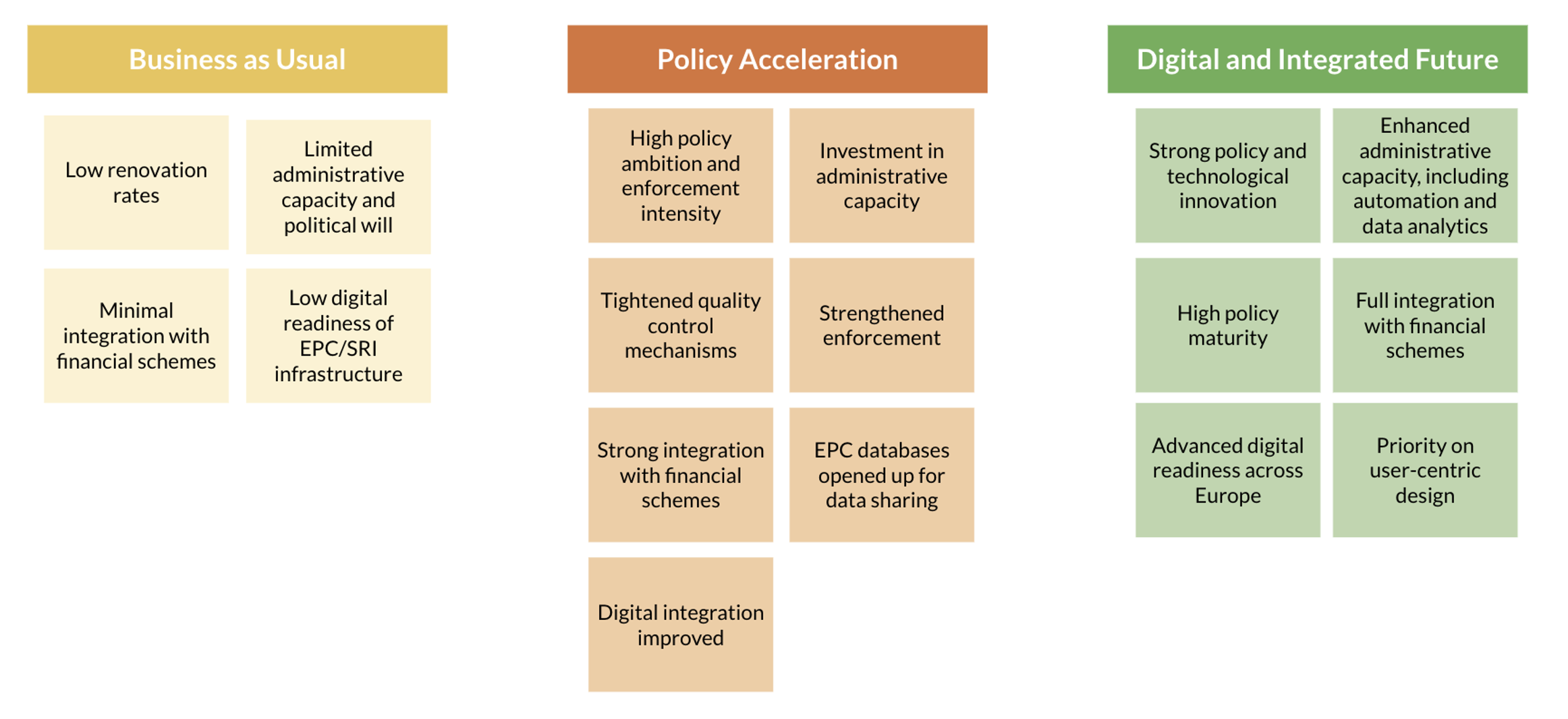
SmarterEPC project: Enabling the integration of energy performance and smart readiness assessments

SmarterEPC project: Enabling the integration of energy performance and smart readiness assessments
The SmarterEPC project explores the integration of the Smart Readiness Indicator (SRI) into Energy Performance Certificates (EPCs), paving the way for implementing Article 15 of the EPBD.
(Note: Opinions in the articles are of the authors only and do not necessarily reflect the opinion of the European Union)
Introduction
The 2024 recast of the Energy Performance of Buildings Directive (EPBD) strengthens the role of the Smart Readiness Indicator (SRI), the EU instrument used to measure the capacity of buildings to improve their energy efficiency and overall performance, to adapt their operation to the needs of their occupants, and to provide flexibility services to the grid. The mandatory application of the SRI to non-residential buildings with a high energy demand is contemplated by the Directive, while the scheme should remain optional for other buildings.
At the moment, there is still a lot to roll out the SRI at a large scale. For instance, the development of buildings’ onsite audit procedures, the training, qualification and certification of building auditors, the accreditation of SRI calculation tools, and the format of SRI certificates are some of the aspects to be addressed in priority.
However, the necessary steps to develop the SRI ecosystem should build on what is already in place in each country regarding the assessment of building performance. The SRI could be implemented in synergy with existing energy performance assessment procedures, tools, and certificate issuance, ultimately supporting property owners and managers in achieving optimal operational conditions for their buildings. For this reason, the EPBD proposes clarifying the complementary relationship between the SRI and Energy Performance Certificates (EPCs).
SmarterEPC’s flexible approach and innovative solutions
The SmarterEPC project is cofunded by the LIFE programme on Clean Energy Transition (CET). When the project was designed, the EPBD recast was still being discussed by the Commission, the Parliament, and the Council. The final provisions concerning the implementation of the SRI were unknown at this stage.
The EPBD recast adopted in 2024 eventually strengthens the role of the SRI, but there is still room for discussion and decisions concerning the rollout of the instrument:
- For non-residential buildings with an effective rated output for heating, ventilation and air-conditioning (HVAC) systems of over 290 kW, new delegated and implementing acts will be adopted and require the application of the SRI for these buildings, taking into account the outcome of a report to be submitted by the Commission to the Parliament and the Council based on the available results of the national test phases and other relevant projects.
- For smaller non-residential buildings and for all residential buildings, other delegated and implementing acts should detail the arrangements for optionally calculating the SRI, taking into account stakeholders' consultations.
The mindset adopted by SmarterEPC is to contribute to the ongoing discussions and consultations by developing tools and solutions, which should not only be compliant with the EPBD but also flexible enough to be adopted by Member States in different contexts, whatever the exact contents of the upcoming delegated and implementing acts are. These solutions must also take into account the significant variations in EPC and SRI uptake and the critical barriers they face, as thoroughly examined in the report 'EPC and SRI current coverage and uptake policies'.
SmarterEPC envisions the first joint EPC and SRI certification workflow creating three main innovations, aligned with the CEN/ISO set of EPBD standards and with the 2024 revision of the EPBD:
- Innovation 1: A standardised onsite audit procedure, which frames data collection based on existing standards.
- Innovation 2: The SmarterEPC Hub - Smart data collection IT interface, designed to read and map variables, preparing the data to be used by EPC and SRI tools, for the calculation of energy performance and smart readiness assessments, respectively.
- Innovation 3: A joint EPC and SRI Certificate template, with EBPD-compliant contents, integrating the outcomes of both assessments.
The workflow developed by SmarterEPC is depicted in Figure 1.

Figure 1: The SmarterEPC project’s approach.
Innovation 1: Standardised onsite audit procedure for multi-purpose buildings’ performance assessment
When the SRI is implemented by Member States (as of 2027), building assessors will need an audit procedure to conduct SRI assessments in a standardised and reliable manner. The CEN-CENELEC Workshop Agreement (CWA) 18193:2025 ‘Standardised on-site audits of Smart Readiness Indicator (SRI) for buildings’, initiated by the Smart Square project and published in March 2025, is the first CEN standardisation document addressing the SRI. This document is a major milestone on the standardisation pathway of this new instrument. It addresses the need for a standardised, step-by-step onsite SRI audit procedure and provides a comprehensive framework to guide auditors, ensuring reliable and consistent assessments of a building's smart readiness.
However, energy performance, smart readiness, and possibly other assessments are likely to be carried out at once by building assessors. This is why another proposal for standardisation –in this case, a pre-normative report– has been initiated by SmarterEPC. The SmarterEPC pre-normative report starts from existing standardisation documents, including the previously mentioned CWA on the SRI. It will go further by developing a combined procedure encompassing other building performance disclosure tools concerning the EPBD: energy performance, renovation passports, and inspections of heating, ventilation, and air conditioning (HVAC) systems.
The SmarterEPC pre-normative report will be evaluated and reviewed by certified EPC assessors from 10 EU countries, and shall be further improved based on their feedback and practical perspective.
This onsite audit procedure will be the basis of the SmarterEPC virtual training centre, which will take further the CEN-CE scheme's Learning Management System. The programme will be delivered in English and will include slides and videos for asynchronous self-paced training, exercises to practice the topic, questionnaires to check learning outcomes and qualify trainees. It will bridge with the training programmes of the EPC and SRI tools integrated into the SmarterEPC hub.
Innovation 2: Calculation of energy performance and smart readiness with the SmarterEPC hub
SmarterEPC is also developing a digital smart data collection interface, the SmarterEPC hub, that eases the input of data required for the calculation of EPC and SRI evaluations. Rather than developing new EPC and SRI tools, the SmarterEPC hub aims to facilitate the use of existing innovative tools calculating EPC and SRI scores developed by other HORIZON 2020, Horizon Europe and LIFE CET projects. The SmarterEPC hub thus supports the post-project exploitation plan of these tools, growing the databases of use cases coming from these tools, thus prolonging their role as policy-making support tools.
The development of the SmarterEPC hub is based on a thorough examination of all the aspects of the EPBD possibly relevant to SmarterEPC: renovation passports, digital building logbooks, technical building systems, data exchange, databases for the energy performance of buildings, inspections and reports of HVAC systems, etc.
The hub is also fed by a detailed review of the EPC tools currently accredited in the 27 EU countries and the innovative EPC and SRI tools developed by other EU projects. Our observations can be found in the report 'Assessment of tools for the calculation of the EPC and the SRI'.
Developed at the EU level, the SmarterEPC hub is designed to evolve towards interoperability with EPC and SRI tools accredited by Member States, in parallel with the progressive alignment of national EPC tools to the CEN/ISO set of EPB standards (also known as the ISO 52000 family).
Innovation 3: SmarterEPC’s EPBD-compliant, integrated EPC and SRI certificate
SmarterEPC has developed a proposal for a joint EPC and SRI certificate that brings together the core aspects of both instruments into a single, user-friendly, and EPBD-aligned certificate template. As explained in the report 'SmarterEPC D3.4 Integration of SRI into the EPC', the proposed certificate template results from a combination of a detailed mapping of EPC and SRI mandatory and optional elements according to the EPBD, with user-centric design principles (see also this recent BUILD UP Technical Article).

Figure 2. SmarterEPC’s proposal for an integrated, EPBD-compliant EPC and SRI certificate.
The SmarterEPC vision for EPC and SRI future trajectories
SmarterEPC’s innovations are made available to the targeted stakeholders via two main channels. First, the SmarterEPC Virtual Training Centre will train building assessors and prepare them to go through the SmarterEPC workflow with success. Second, the SmarterEPC Support Centre for EU-level, national, and regional authorities aims to be the single-entry point to access the latest information from EU projects regarding the SRI, the evolution of EPCs, and the integration of both schemes.
Three prospective scenarios envisaged by SmarterEPC explore the uptake of EPC and SRI in the EU, depending on different key drivers and assumptions at the country level (e.g. renovation rates, administrative capacity, enforcement intensity, policy maturity, integration with financing, and digital readiness). They reflect different levels of policy ambition, enforcement, and digital integration. Each scenario projects potential trajectories for EPC and SRI implementation from 2025 to 2040, highlighting the policy actions and innovations required to enhance coverage, compliance, and impact.

Figure 3. Drivers and assumptions for the three SmarterEPC’s prospective scenarios.
In the first scenario, 'Business as Usual', only minimal new measures are introduced beyond current practices. EPC issuance continues to be driven primarily by natural trigger points, properties being sold or rented, and new constructions requiring certification. As a result, this scenario portrays a continuation of the status quo: slow incremental progress in EPC coverage and almost negligible adoption of SRI, constrained by weak enforcement and lack of strong new incentives or digital integration.
The second scenario, 'Policy Acceleration', assumes the full and effective transposition of the EPBD revision by all Member States, coupled with robust enforcement. In summary, this scenario achieves high coverage through classic regulatory push, every building is reached by the EPC mandate and large buildings by the SRI mandate, underpinned by strong enforcement and improved linkage to renovation incentives. It stops short of full digital transformation, but it lays the groundwork (via open data and standardised schemes) for a more integrated future.
Finally, a third scenario, 'Digital and Integrated Future Actions', represents a high-ambition world where policy, market, and technology trends converge to produce widespread uptake of EPCs and SRIs, facilitated by advanced digital infrastructure. In addition to fully implementing the EPBD measures, this scenario assumes strong investment in digital tools, data platforms, and integration of building information. In sum, this scenario achieves near-universal coverage of EPCs and a high uptake of SRI by leveraging policy enforcement and digital innovation in tandem. It paints a picture of an EU building stock where energy performance and smart capability information is readily available for virtually every building, thereby supporting not only regulatory compliance but also smarter decision-making in real estate and renovation markets.
Conclusions
Supported by SmarterEPC advisory board of experts, the SmarterEPC partners make their best efforts to produce standardised and handy reference documents and innovative tools to be used by national authorities looking for support to speed up the uptake of energy performance and smart readiness assessments.
The SmarterEPC Fit for 290kW roadmap aligns with the need to accelerate policy actions to achieve high coverage of EPC and SRI by 2040. Under this scenario, underpinned by strong enforcement and improved linkage to renovation incentives, SmarterEPC believes that, through classic regulatory pushes, every building could be reached by the EPC mandate and large buildings by the SRI mandate by 2040.
The SRI scheme intends to raise awareness among building owners and occupants of the value behind building automation and electronic monitoring of technical building systems, exactly as EPCs were designed, 20 years ago, to inform property buyers, tenants, and owners about the energy performance of a building. Along these lines, SmarterEPC is starting to work on making EPCs and the SRI more salient in investment decisions, real estate valuation, and access to financing.

